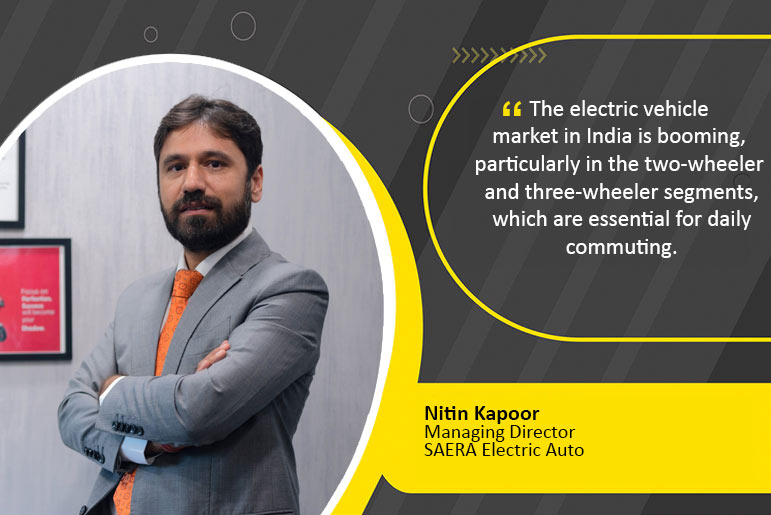In the global race towards a greener future, few innovations have gained as much momentum as electric vehicles (EVs). Once seen as a niche technology, EVs are now emerging as the heroes of sustainable transportation, offering a cleaner alternative to traditional internal combustion engine (ICE) vehicles. But here’s the catch: electric vehicles can only reach their full environmental potential when powered by clean, renewable energy sources. Imagine a future where every electric vehicle is charged by the sun, the wind, or even flowing rivers—that’s the world we’re moving toward.
In countries like India, where the demand for transportation is soaring, this collaboration between renewable energy and EVs holds the key to building a more sustainable and environmentally friendly future.
India’s Bold Shift: Driving Change with Renewables and EVs
India is at the forefront of a dramatic transformation in energy, striving to meet growing demands while addressing the urgent need to protect the environment. Already one of the world’s top four renewable energy producers, India had installed an impressive 201.45 gigawatts (GW) of renewable capacity by October 2024. And with its transportation sector contributing a significant 18% of national greenhouse gas emissions, this achievement is far more than just a milestone—it’s a game changer.
India has set ambitious goals to dramatically expand its renewable energy sources to power the growing fleet of electric vehicles. By 2030, the country aims to have 500 GW of non-fossil electricity capacity. This isn’t just about hitting numbers; it’s about fundamentally transforming how the nation moves, quite literally, toward a cleaner future.
The Electric Surge: India’s Growing EV Revolution
The electric vehicle market in India is booming, particularly in the two-wheeler and three-wheeler segments, which are essential for daily commuting. In 2023, EVs made up about 5% of total vehicle sales, but that number is expected to skyrocket to over 40% by 2030 and 50% by 2035. In fact, 90%-94% of India’s electric vehicle sales come from two- and three-wheelers, making electrification a huge part of everyday life.
This revolution is fuelled by strong government support. The FAME-II (Faster Adoption and Manufacturing of Hybrid and Electric Vehicles) scheme, with a whopping budget of INR 10,000 crore, is a key player. FAME-II offers generous subsidies for purchasing EVs—everything from two-wheelers and buses to support for charging infrastructure. It’s part of a bigger vision under the National Electric Mobility Mission Plan (NEMMP) to make electric vehicles not just a viable option, but a preferred one for millions.
But it’s not just about making electric vehicles available; it’s about making them affordable and practical. India’s Production Linked Incentive (PLI) scheme is geared toward producing advanced EV batteries domestically, aiming to reduce the country’s reliance on imports and bring down costs. The more affordable the battery, the more accessible the EV, and the faster the adoption.
The EV Ecosystem: Building a Future on Clean Energy
However, there’s a vital piece of the puzzle that can’t be overlooked. For electric vehicles to truly deliver on their promise of sustainability, they must be powered by clean energy. Right now, much of India’s electricity still comes from coal, which means that simply switching to electric vehicles without shifting to renewables would do little to reduce overall emissions. Here lies the golden opportunity: India’s rapidly expanding renewable energy capacity.
Solar power, in particular, stands as a beacon of hope. India is blessed with abundant sunlight, and harnessing this resource through solar-powered charging stations in urban areas can drastically reduce the carbon footprint of EVs. Imagine charging your car on the power of the sun! It’s a reality that’s becoming increasingly common, especially with state governments actively promoting solar initiatives to meet rising energy demands. As solar energy becomes more prominent in India’s energy mix, it will ensure that electric vehicles run on the clean, renewable power they were designed for.
But the story doesn’t end with solar. Wind and hydropower are also crucial in this transition. The integration of renewable sources into India’s power grid will not only cut emissions but also help manage the growing demand for electricity as more EVs hit the road. Distributed solar generation, for example, can ease pressure on the grid during peak hours, ensuring that even with the rise of EVs, there are no blackouts or energy shortages. It’s a vision of a seamlessly sustainable, scalable mobility system.
Government Policies: Leading the Charge Toward a Greener Tomorrow
India isn’t just passively waiting for this change—it’s leading the charge. The government has rolled out several initiatives to support the growth of EVs and the shift to renewable energy. FAME-II, with its subsidies for vehicle purchases and investments in charging infrastructure, is already making waves. And state-level policies are adding more incentives, making it easier for both manufacturers and consumers to embrace electric mobility.
Additionally, the PLI scheme for battery production is a game changer. By promoting domestic manufacturing of advanced chemistry cell (ACC) batteries, India is reducing its dependence on imports, creating jobs, and driving down costs. This not only makes EVs more affordable but also speeds up their adoption across the country.
Conclusion: Powering the Future with Renewables and EVs
The marriage of renewable energy and electric vehicles is not just a technological necessity—it’s an economic and ecological imperative. By embracing this synergy, India is not only cutting its carbon emissions but also boosting energy security and fostering economic growth in new industries.
As India’s renewable energy capacity continues to grow, and as more electric vehicles take to the roads, the country is poised to become a global leader in sustainable transportation. A future where electric cars are powered by the wind, the sun, and water is no longer a distant dream—it’s a reality being built today. Together, renewable energy and electric vehicles are driving India toward a cleaner, greener, and more prosperous tomorrow.


